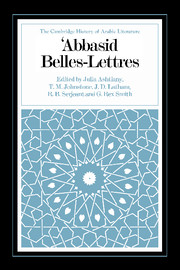Book contents
- Frontmatter
- The ʿAbbasid Caliphate: a historical introduction
- 1 Adab and the concept of belles-lettres
- 2 Shuʿūbiyyah in Arabic literature
- 3 Ibn al-Muqaffaʿ and early ʿAbbasid prose
- 4 Al-Jāḥiẓ
- 5 Al-Ṣaḥib Ibn ʿAbbād
- 6 Abū Ḥayyān al-Tawḥīdī
- 7 Al-Hamadhānī, al-Ḥarīrī and the maqāmāt genre
- 8 Fables and legends
- 9 ʿAbbasid poetry and its antecedents
- 10 Hunting poetry (ṭardiyjāt)
- 11 Political poetry
- 12 Love poetry (ghazal)
- 13 Wine poetry (khamriyyāt)
- 14 Mystical poetry
- 15 Ascetic poetry (zuhdiyyāt)
- 16 Bashshār b. Burd, Abū ʾl-ʿAtāhiyah and Abū Nuwās
- 17 Al-Mutanabbī
- 18 Abū Firās al-Ḥamdānī
- 19 Abū ʾl-ʿAlāʾ al-Maʿarrī
- 20 Literary criticism
- 21 Ibn al-Muʿtazz and Kitāb al-Badīʿ
- 22 Regional literature: Egypt
- 23 Regional literature: the Yemen
- Appendix: Table of metres
- Bibliography
- Index
2 - Shuʿūbiyyah in Arabic literature
Published online by Cambridge University Press: 28 May 2012
- Frontmatter
- The ʿAbbasid Caliphate: a historical introduction
- 1 Adab and the concept of belles-lettres
- 2 Shuʿūbiyyah in Arabic literature
- 3 Ibn al-Muqaffaʿ and early ʿAbbasid prose
- 4 Al-Jāḥiẓ
- 5 Al-Ṣaḥib Ibn ʿAbbād
- 6 Abū Ḥayyān al-Tawḥīdī
- 7 Al-Hamadhānī, al-Ḥarīrī and the maqāmāt genre
- 8 Fables and legends
- 9 ʿAbbasid poetry and its antecedents
- 10 Hunting poetry (ṭardiyjāt)
- 11 Political poetry
- 12 Love poetry (ghazal)
- 13 Wine poetry (khamriyyāt)
- 14 Mystical poetry
- 15 Ascetic poetry (zuhdiyyāt)
- 16 Bashshār b. Burd, Abū ʾl-ʿAtāhiyah and Abū Nuwās
- 17 Al-Mutanabbī
- 18 Abū Firās al-Ḥamdānī
- 19 Abū ʾl-ʿAlāʾ al-Maʿarrī
- 20 Literary criticism
- 21 Ibn al-Muʿtazz and Kitāb al-Badīʿ
- 22 Regional literature: Egypt
- 23 Regional literature: the Yemen
- Appendix: Table of metres
- Bibliography
- Index
Summary
One of the most striking movements in Arabic cultural history and literature, especially during the third/ninth century, is that assertive movement, collectively known as Shuʿūbiyyah, which represented a powerful, sometimes extreme, backlash amongst the conquered peoples against the Arabs of Arabia in particular, and has been characterized as “a more or less successful attempt on the part of the different subjected races to hold their own and to distinguish, at least, between Arabism and Islam”. The whole movement, however diversified and uncoordinated it may have been, extended from Spain and the furthest Maghrib to the remoter parts of Central Asia, and was especially espoused by the Persians and by the Aramaeans (Nabaṭ) of Iraq.
Opinion now favours the view that the bitter attacks directed against the Arabs in the literature of the third/ninth century were probably not the expression of nationalism, Persian nationalism in particular, but rather a movement, widespread among the new middle class of mixed race and the influential government secretaries (kātibs), aimed at remoulding the political and social institutions and the whole spirit of Islamic culture on the model of Sasanian institutions and values, which were then in favour and which the new urban society and the administrative class held forth as the highest ideal. It is clear, though, that the movement was not confined to secretaries, but was wider, nor can its aims be so clearly defined.
- Type
- Chapter
- Information
- Abbasid Belles Lettres , pp. 31 - 47Publisher: Cambridge University PressPrint publication year: 1990
- 7
- Cited by



